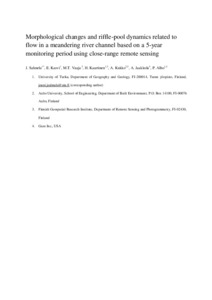Morphological changes and riffle-pool dynamics related to flow in a meandering river channel based on a 5-year monitoring period using close-range remote sensing
Kukko A; Salmela J; Alho P; Kasvi E; Vaaja MT; Kaartinen H; Jaakkola A
https://urn.fi/URN:NBN:fi-fe2021042825477
Tiivistelmä
The maintenance of riffle-pool sequences and morphological changes in the long-term have received little attention in the literature. The aims of this study are to determine morphological changes and riffle-pool maintenance in relation to flow conditions in a meandering river channel over a 5-yr period. Change detection was focused on riffle and pool maintenance in a river reach covering three successive meander bends. Changes in a meandering river channel were studied utilizing detailed digital terrain models and flow data. The results indicated that riffle-pool sequences are maintained by high discharge events and the development of pools and riffles was linked. During high discharges, the riverbed eroded on the concave sides and the inflexion points aggraded, causing riffle–pool sequences, whereas during low discharges, concave sides aggraded and inflexion points eroded, causing pool filling and riffle erosion. While discharge increased, near-bed flow velocities increased faster on the concave sides of the bends than at the inflexion points, becoming higher at a discharge of 8 m3/s, ~20% of the bankfull discharge. Changes in the three successive meander bends were mainly similar, and the geometry of meandering rivers contributed to the locations of riffles and pools. Pools and riffles were not stable in size and shape, but their longitudinal location remained the same, instead of migrating up and down the channel. Morphological changes occurred in meander bends year-round, but they were non-linear. Annual channel change was not similar from year to year owing to different flow regimes and morphological changes during the previous year. However, seasonal detection revealed similarities between high and low discharge periods between the years. Concave sides of meander bends may act to temporarily store sediment; however, storage is preserved only under the effective hydrological discharge.
Kokoelmat
- Rinnakkaistallenteet [19218]
